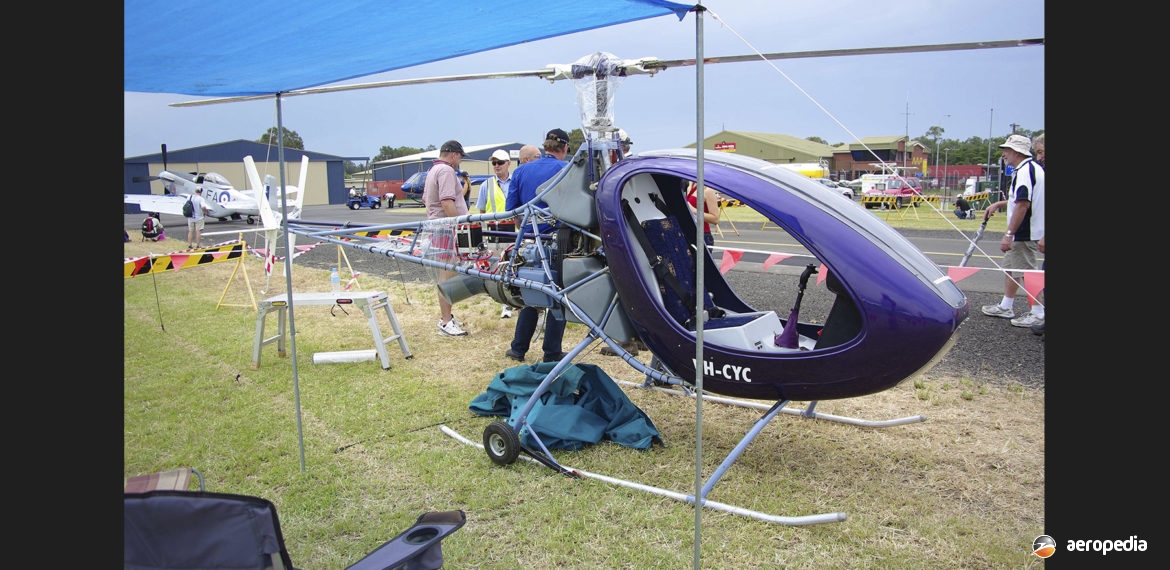Photograph:
Eagle Research & Development Helicycle VH-CYC (c/n 2.15) on display at Albion Park, NSW in February 2010 (David C Eyre)
Country of origin:
United States of America
Description:
Single-seat light sport helicopter
Power Plant:
One 67 kw (90 hp) modified Solar T-62 turbine engine
Specifications:
- Rotor diameter: 6.4 m (21 ft)
- Length: 5.63 m (18 ft 6 in)
- Max speed at sea level: 177 km/h (110 mph)
- Max cruising speed: 153 km/h (95 mph)
- Rate of climb: 274 m/min (900 ft/min)
- Service ceiling: 3,353 m (11,000 ft)
- Range with no reserve: 257 km (160 miles)
- Empty weight: 227 kg (500 lb)
- Loaded weight: 386 kg (850 lb)
History:
The Helicycle was designed as a light single-seat sport helicopter by Eagle Research & Development of Caldwell, Idaho, and has received much development since it was designed by B J Schramm in the 1960s. At one stage Mr Schramm designed and built a 112 kw (150 hp) [800 cc] liquid-cooled engine for homebuilt helicopters, and was involved in designing the Rotorway Windstar helicopter.
Construction was of chrome molybdenum tubular steel airframe with a fibreglass cockpit, a skid undercarriage, and an open tail boom. A variety of power plants has been installed over the years, at one stage being fitted with two 7.46 kw (10 hp) McCulloch engines in pusher configuration, one on each side of the cockpit on stub wings, the latter at that time containing the fuel tanks. It was designed to operate in three modes: conventional helicopter mode, compound mode using main rotor torque and pusher thrust, and autogyro mode using the pusher engines only.
Eventually it was developed to take a single power plant in the ordinary helicopter mode, and the Rotax 618 engine was installed, but this was not particularly successful. Later the Hirth three-cylinder two-stroke electronic fuel-injected unit became standard and this was fitted in the United States to a number of kit-built aircraft. Later again the 63 kw (85 hp) Rotax 670 two-cylinder horizontally-opposed air-cooled engine was installed. Eventually one builder installed a Solar T-62 turbine engine, this being a former auxiliary power unit (APU) de-rated from 119 kw (160 hp) to 67 kw (90 hp), which had a modified gearbox making it simple to install, and this became the unit usually installed.
A number of examples have been imported to this region, the first completed becoming VH-ZHR (c/n 2.33) to its owner/builder at Baulkham Hills, NSW in August 2004, but this was damaged in an accident near Richmond, NSW on 13 October 2007. Another was registered in Australia in October 2009, becoming VH-CYC (c/n 2.15) to Teliflite Pty Ltd of Bomaderry, NSW, this aircraft suffering an accident and being written off on 2 December 2015. This was followed in October 2012 by VH-ZTZ (c/n 6.18) to Heliwest of Jandakot, WA; VH-CIC (c/n 3.01); VH-ZUL (c/n 7.86); VH-DEA (c/n 2.01); VH-ZPD² (c/n 6.01BH) registered on 13 November 2017; and VH-ARG4 (c/n E2.418) on 21 February 2018.
At least one has been imported and assembled in New Zealand, becoming ZK-HJU (c/n 2.17) but crashed on 10 December 2006 when it lost its tail rotor south of Auckland. It was subsequently exported to South Africa as ZU-RBG in July 2007.

